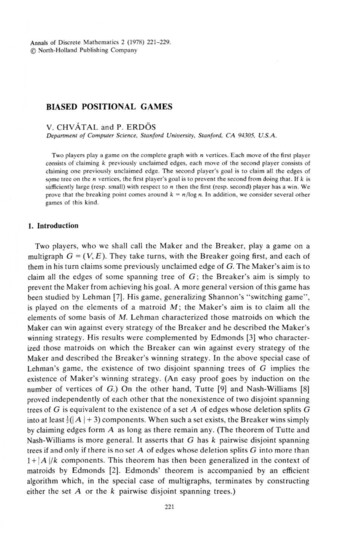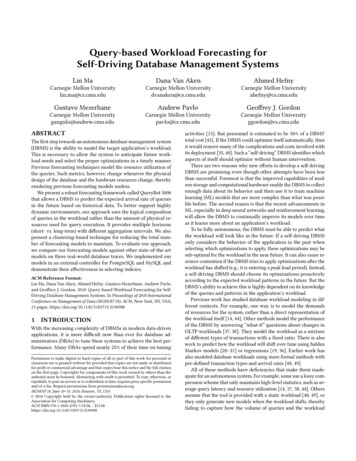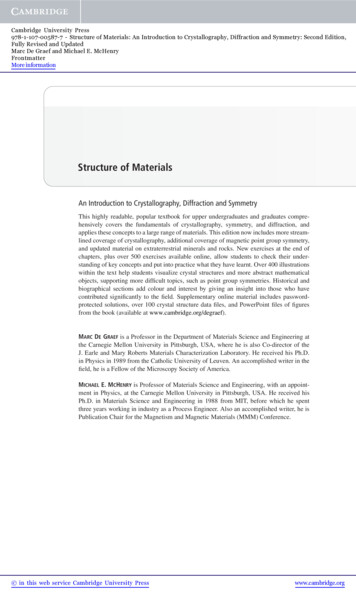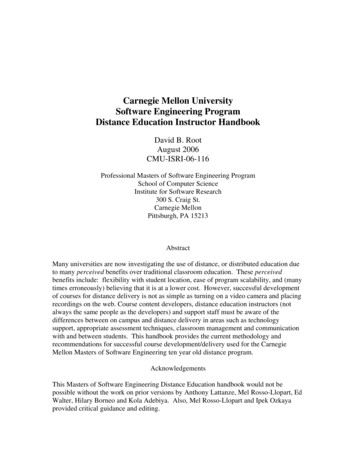
Transcription
Annals of Discrete Mathematics 2 (1978) 22 1 -229 . North-Holland Publishing CompanyBIASED POSITIONAL GAMESV . CHVÁTAL and P . ERDOSDepartment of Computer Science, Stanford University, Stanford, CA 9430 5, U.S.A .Two players play a game on the complete graph with n vertices . Each move of the first playerconsists of claiming k previously unclaimed edges, each move of the second player consists ofclaiming one previously unclaimed edge . The second player's goal is to claim all the edges ofsame tree on the n vertices, the first player's goal is to prevent the second from doing that . If k issufficiently large (resp . small) with respect to n then the first (resp . second) player has a win . Weprove that the breaking point comes around k n/log n . In addition, we consider several othergames of this kind .1 . IntroductionTwo players, who we shall call the Maker and the Breaker, play a game on amultigraph G (V, E) . They take turns, with the Breaker going first, and each ofthem in his turn claims some previously unclaimed edge of G . The Maker's aim is toclaim all the edges of some spanning tree of G ; the Breaker's aim is simply toprevent the Maker from achieving his goal . A more general version of this game hasbeen studied by Lehman [7] . His game, generalizing Shannon's "switching game",is played on the elements of a matroid M ; the Maker's aim is to claim all theelements of some basis of M. Lehman characterized those matroids on which theMaker can win against every strategy of the Breaker and he described the Maker'swinning strategy . His results were complemented by Edmonds [3] who characterized those matroids on which the Breaker can win against every strategy of theMaker and described the Breaker's winning strategy . In the above special case ofLehman's game, the existence of two disjoint spanning trees of G implies theexistence of Maker's winning strategy . (An easy proof goes by induction on thenumber of vertices of G .) On the other hand, Tutte [9] and Nash-Williams [8]proved independently of each other that the nonexistence of two disjoint spanningtrees of G is equivalent to the existence of a set A of edges whose deletion splits Ginto at least 21 (1 A 3) components . When such a set exists, the Breaker wins simplyby claiming edges form A as long as there remain any . (The theorem of Tutte andNash-Williams is more general . It asserts that G has k pairwise disjoint spanningtrees if and only if there is no set A of edges whose deletion splits G into more than1 I A ilk components . This theorem has then been generalized in the context ofmatroids by Edmonds [2] . Edmonds' theorem is accompanied by an efficientalgorithm which, in the special case of multigraphs, terminates by constructingeither the set A or the k pairwise disjoint spanning trees .)
V Chvátal P ErdősWhen played on a large complete graph with n vertices Lehman s game isoverwhelmingly in favor of the Maker We shall make up for this handicap byallowing the Breaker to claim many edges per move More precisely we shallchoose a positive integer b and let each move of the Breaker consist of claiming bpreviously unclaimed edges Clearly if b is large with respect to n then the firstplayer has a win ; if b is small with respect to n then the second player has a winThe following heuristic argument suggests the breaking point ought to come aroundn log n The duration of the game allows for approximately n b Maker s edgesIn particular if b n c log n then the Maker will have the time to create a graphwith cn log n edges A random graph with n vertices and en log n edges is almostcertainly connected for c and almost certainly disconnected for c Thatis the statement of an unpublished theorem by Erdös and Whitney which has beensharpened by Erdös and Rényi [4] We shall prove that the breaking point doesindeed come around b n log n ; more precisely it is between n 4 F log n andn log n for all sufficiently large nILehman s switching game belongs to the general class of positional gamesstudied by Hales and Jewett [6] Erdös and Selfridge [5] Berge [ ] and others Ofcourse every positional game can be made biased by allowing one or both of theplayers to claim more than one position per move Those games that we shall studyhere fall into the following general pattern They are played on some hypergraphH The two players the Breaker and the Maker take turns in claiming previouslyunclaimed vertices ; the Breaker has the first move On each move the Breakerclaims exactly b vertices and the Maker claims exactly m vertices The Maker s aimis to claim all the vertices of some edge ; the Breaker s aim is simply to prevent theMaker from doing so In the next section we shall solve an extremely simple gameof this kind : b l the edges of H are pairwise disjoint and almost equal in sizeThe solution to this box game will be handy in two different contexts when weshall discuss the biased version of Lehman s game In the following three sectionswe shall study games for which m and the vertices of H are the edges of acomplete graph For the edges of H we shall successively take spanning treeshamiltonian cycles and complete subgraphs of prescribed size The last of thesegames generalizes quite naturally into the context of r graphsThe box gameWe shall say that a hypergraph H is of type k t if its edges A AA arepairwise disjoint and such that I I A ; ! t If in addition the edges are almostequal in size that is if I A ; ! and A ; ! differ by at most one for all choices of i and jthen we shall say that H is canonical of type k t The box game B k7 t m isplayed on a canonical hypergraph of type k t The two players take turns withthe Breaker having the first move in claiming previously unclaimed vertices of HOn each move the Breaker claims only one vertex whereas the Maker claims mvertices The Maker s aim is to claim all the vertices of some edge A
Biased positional games3It is convenientclaiming a vertexclaiming a vertexHence after eachto think of the actions of the two players in the following way Byfrom some edge A ; the Breaker removes this edge from H ; byv from some edge A the Maker replaces this edge by A ; {v}move of the Maker and the counter move of the Breaker thehypergraph H reduces into a new hypergraph H* Note that the Maker can alwaysplay in such a way that the new hypergraph H* is again canonicalIn order to present a solution of B k t m we shall define f m andf k m [k f kmmkJfor all positive integers k and m such that k akmkI TheoremIikf k m mkIIt is not difficult to verify thatI7The Maker has a winning strategy on B k t mifand onlyift f k mProof To prove the if part we shall use induction on k Responding toBreaker s move the Maker can create a canonical hypergraph H* of typek l t* such that t* t LtkJrn Since the right hand side of this inequalitym we are doneis at most f kTo prove the only if part we shall again use induction on k This timehowever we shall prove a slightly stronger statement : if t f k m then theBreaker has a winning strategy for the box game played on an arbitrary notnecessarily canonical hypergraph of type k t The strategy consists of removingat each move the smallest available edge No matter how the Maker responds theresulting hypergraph H * will be of type kt* such that t * t Lt k f mSince the right hand side of this inequality is strictly greater than f km weare done again3 Spanning treesBy T n b we shall denote the biased version of Lehman s game described in theintroduction : the Breaker claims b edges per move and the Maker wants a spanningtreeIf e is positive if n n ETheorem 3Breaker has a winning strategy for T n band if b E n log n then theProof The Breaker proceeds in two stages In the first stage he will claim all theedges of some clique C with k vertices such that k n log nI and such thatnone of the Maker s edges has an endpoint in C In the second stage he will claimall the remaining edges incident with some v E C thereby preventing the Maker
4V Chvátal P Erdősfrom joining v to other vertices The first stage lasts no more than k moves During t k the Breaker has created a clique C with tthe first tmovesvertices such that none of the Maker s edges has an endpoint in C At the momentthere are exactly tMaker s edges ; hence there are vertices u v C which areincident with none of the Maker s edges On his t move the Breaker claims theedge uv and all the edges joining u and v to vertices from C thereby enlarging Cby two vertices The Maker may in his turn eliminate one vertex from C byclaiming an edge incident with that vertex Nevertheless the size di C will still haveincreased by at least one vertex In the second stage the Breaker thinks of every setof edges joining some u E C to all v V C as the edge of a canonical hypergraph oftype k t with t k n k He then plays the box game on this hypergraphpretending to be the Maker By Theoremthe inequalityktbk iis sufficient to guarantee his victory And as can be seen after the appropriatesubstitutions this inequality is indeed satisfiedOur next theorem provides a winning strategy for the Maker We shall describe itin the more general context of the game T G b which is played on the edges of amultigraph GTheorem 3Let G V E be a multigraph with n vertices and let b be a positiveS andinteger Assume that for every subset S of V and for every vertex v such that vJSj nmore thanb edges of G join v to vertices of S Then the Maker has a winning strategy for T G bProof For each u E V we shall denote by dk u the number of edges of G thatare incident with u and have been claimed by the Breaker during his first k movesFor each subset S of V we shall definedk S min d k UESWe shall denote by Mk the subgraph of G consisting of the edges claimed by theMaker within his first k moves The strategy is quite simple : after the Breaker s kmove the Maker finds a component A of Mk which maximizes d k C over allcomponents C of Mk We guarantee that there will be an unclaimed edge joiningA to V A This will be proved below The Maker claims this edge and theBreaker resumes the play Making his ns move in this fashion the Maker willcomplete a tree on n vertices and win
Biased positional games5In order to prove that this strategy can be carried out we shall denote thefollowing hypothesis by H k : for every integer t such thattn kandfor every choice of components C CC of Mkwe have dkC bt Eholds trivially since d„ u for every vertex u Assuming H kNote that Hwe shall derive the existence of the unclaimed edge joining A to V A andestablish the validity of H kTo begin with we havedk CbdkCbt :5 tfor every choice of components C Gdk C C of MkIn particular we havebY for every component C of Mkone vertex u such thatdk u iHence every component of Mkincludes at leastb From this fact and from the hypothesis of our theorem it follows thatfor every component C of Mk and for every subsetS of V such that I S I n and C n s thereis an unclaimed edge uv such that u E C v E SNow the existence of an unclaimed edge joining A to V A follows immediately :then we usewith C A and S V A if A nif J A I nthen we usewith S AFor each component C of Hkwe shall choose aIt remains to verify H kvertex u such that dk u d k C ; we shall call this vertex the root of C Bywehave3dk u ; bt e t for every choice of roots u u u„ such that I troot of A ; by maximality of dk A we havedk wdk ufor every root uNow let us assume H kt dk C b tkLet w denote the4false Then we have 5Ufor some integer t such that ntnk and for some choice of components
6V Chvátal P ErdősC CCuw ; by 5of Mk Note that each C includes exactly one root u; such thatwe havetdk u;dk C b ty Setting u w and using 4 we obtainE dk ucontradicting 3%t ltJ: dk u btEHence H kCorollary 3 3is valid and the proof is completedIfs is positive if n n shas a winning strategy for T n band if b n4log n then the MakerRemark Bondy observed that there are multigraphs G with an arbitrarily largenumber of pairwise disjoint spanning trees and yet such that the Breaker can wineven T GThe simplest example is the path of length n each of whose edges hasmultiplicity s For this G the Breaker can view T Gas the box gameB ns nwith himself in the role of the Maker Ifs then by Theoremhe has a win At the same time however G has s pairwisedisjoint spanning trees4 Hamiltonian cyclesBy H n b we shall denote the game which differs from T n b in only onerespect : the Maker s aim is to claim all edges of some hamiltonian cycle What is thelargest f n such that the Maker has a winning strategy for H n f n ? In thissection we shall prove that f nfor all sufficiently large n It is not unlikely thatf nx as nx ; however we cannot even prove that f n for all sufficientlylarge nTheorem 4For all sufficiently large n the Maker has a winning strategy forH nProof The strategy proceeds in three stages The first stage is the simplest It lastsexactly m [ n 3] moves ; by the end of that stage the Maker will have claimed allthe edges of some cycle G whose length is between n 4 and n 3 In his first kmoves k m the Maker has claimed all the edges of some path u u z u k Inhis k h move he claims a previously unclaimed edge u k v such that vX u ; for all i ;
Biased positional games7on his m h move he claims a previously unclaimed edge u i u; such that i n 4and 7n 4 j mBy the end of the first stage at most eight vertices outside C have at least n 4Breaker neighbours that is neighbours in the Breaker s graph in G Such verticeswill be called dangerous For each dangerous vertex v the Maker will use fourmoves to enlarge his current cycle C into a cycle C* containing v Hence the entiresecond stage will last at most 3 moves In order to construct C* the Maker firstfinds three vertices w w w outside C such that the edges vw vw vw areunclaimed and such that each w ; has at most n 4 3 Breaker neighbours in CThis can be done for the following reason The vertex v has Breaker degree atmost n 3 3 ; the cycle C has length at most n 3 3 Hence there are at leastn 3 65 vertices w outside C such that vw is unclaimed If all but possibly two ofthem had at least n 4Breaker neighbours in C then the Breaker s graph n 3 3 edges a contradiction Thewould have at least n 3 65 n 4Maker claims vwi and after the Breaker s next move he claims another vw ; Afterthe following move of the Breaker each of the two vertices w ; and w; still has lessthan n 4 Breaker neighbours in C An easy averaging argument shows that theremust be three consecutive vertices u w u on C such that none of the edges w i c kand w u has been claimed The Maker claims w i u and on his next move eitherw ;u or w ;uWhen the second stage is over every vertex outside the Maker s current cycle Chas at most n 4 3 n 8 Breaker neighbours in C If at some time during thethree stages a vertex v outside C will have at least n 8 Breaker neighbours in Cthen we shall call v outstanding The Maker proceeds in steps each step consistingof two moves He selects a vertex v outside C preferably an outstanding one ifthere is any and in two moves he enlarges C into a cycle C* containing v Hencethe entire game will be over in fewer than n moves Consequently at most 7outstanding vertices will make their appearance ; each of them will wait no morethan 44 moves for the inclusion into C During that waiting time the number of its44 nBreaker neighbours in C may grow to at most n 8We conclude that at every point of the third stage every vertex v outside C will have fewerBreaker neighbours in C An easy averaging argument shows that therethan nthreeconsecutive vertices u u u 3 on C such that all three edges vuk arewill beunclaimed In order to enlarge C into C* the Maker claims first the edge u v andon his next move either u v or u v5 Complete subgraphsBy C n 3 b we shall denote the game which differs from T n b and H n bin the Maker s aim : he wants to claim all three edges of some triangleTheorem 5If b n5then the Maker has a winning strategy for
8V Chvátal P ErdősC n 3 b On the other hand if bfor C n3 bthen the Breaker has a winning strategynProof The Maker chooses a vertex u and claims as many edges incident with u aspossible When all the edges incident with a have been claimed he finds anunclaimed edge vw such that both uv and uw have been claimed by himself ;claiming vw he wins Of course we have to show that he can always carry out thisplan Let us assume that he cannot Then at some point of the game he hasd edges uv as well asclaimed exactly d edges uv ; all the remaining nd dedges vw have been claimed by the Breaker Hencend dd dbHowever this inequality has no solution d as long as4bb8n7 which is the case when b n5Next let us describe the Breaker s strategy If the Maker has just claimed someedge uv then the Breaker will claim [n j J edges incident with u and [n Z ] edgesincident with v Hence the degree of w in the Maker s graph will never exceed[n ]Of course the Breaker must prevent the Maker from completing atriangle Hence he must claim immediately every edge xy such that for somevertex z both of the edges xz and yz have been claimed by the Maker Since hedoes so systematically the only dangerous edges xy at the moment have either theform uy such that vy is the Maker s edge or the form vy such that uy is the Maker sthere are atedge Since the Maker degree of u and v does not exceed Ln Jmost [n ] dangerous edges of each kind Hence the Breaker will be able to claimthem allThe concept of C n 3 b generalizes into that of C n r k b This game isplayed on the edges of a complete r graph with n vertices each edge being anr subset of the fixed n set of vertices The Breaker claims b edges per move ; theMaker wants to claim all the ; edges of some complete r graph with k verticesr there isFor every choice of positive integers r k and b such that ka positive integer n r k b with the following property : for every n n r k b theMaker has a winning strategy for C n r k bTheorem 5and n r r b is the smallest integer x suchProof Trivially nk b k bthat b By double induction on r and k it will suffice to prove that the Makerhas a winning strategy for C n r k b as long asnln rn r kbb6The Maker proceeds in two stages In the first stage selecting some vertex v he willclaim only those edges S for which v E S He will interpret each of them as the
Biased positional games9set S {v} ; similarly he will interpret each of the Breaker s edges T as someset T* such that v T* T* C T Altogether he will interpret the first stagern r kb b By 6 he has a winning strategy foras the game C nthis game ; he will indeed follow that strategy By the end of the first stage there willb v X and such that for eachbe a set X of vertices such that I X n r krsubset A of X the edge A U {v} has been claimed by the Maker In thesecond stage the Maker will simply play C X r kb restricting his choice ofedges to subsets of XrrIReferences[ ] C Berge Sur les jeux positionnels Cahiers Centre Études Recherche Opér 8 976[ ] J Edmonds Minimum partition of a matroid into independent subsets J Res Nat Bur Stand 69B965 67 7[3 J Edmonds Lehman s switching game and a theorem of Tutte and Nash Williams J Res Nat BurStand 69B 965 73 77Pub] Math Debrecen 6 959 9[4] P Erdős and A Rényi On random graphs97[5] P Erdős and J Selfridge On a combinatorial game J Combinatorial Theory 4 973 98 3[6 A W Hales and R Jewett Regularity and positional games Trans Amer Math Soc 6 9639[7 A Lehman A solution of the Shannon switching game Siam J964 687 7 5[8 C St J A Nash Williams Edge disjoint spanning trees of finite graphs J London Math Soc 3696 445 45[9 W T Tutte On the problem of decomposing a graph into n connected factors J London MathSoc 36 963
BIASED POSITIONAL GAMES V. CHVÁTAL and P. ERDOS Department of Computer Science, Stanford University, Stanford, CA 9430_5, U.S.A. Two players play a game on the complete graph with n vertices. Each move of the first player consists of claiming k previously unclaimed edges, each move of










